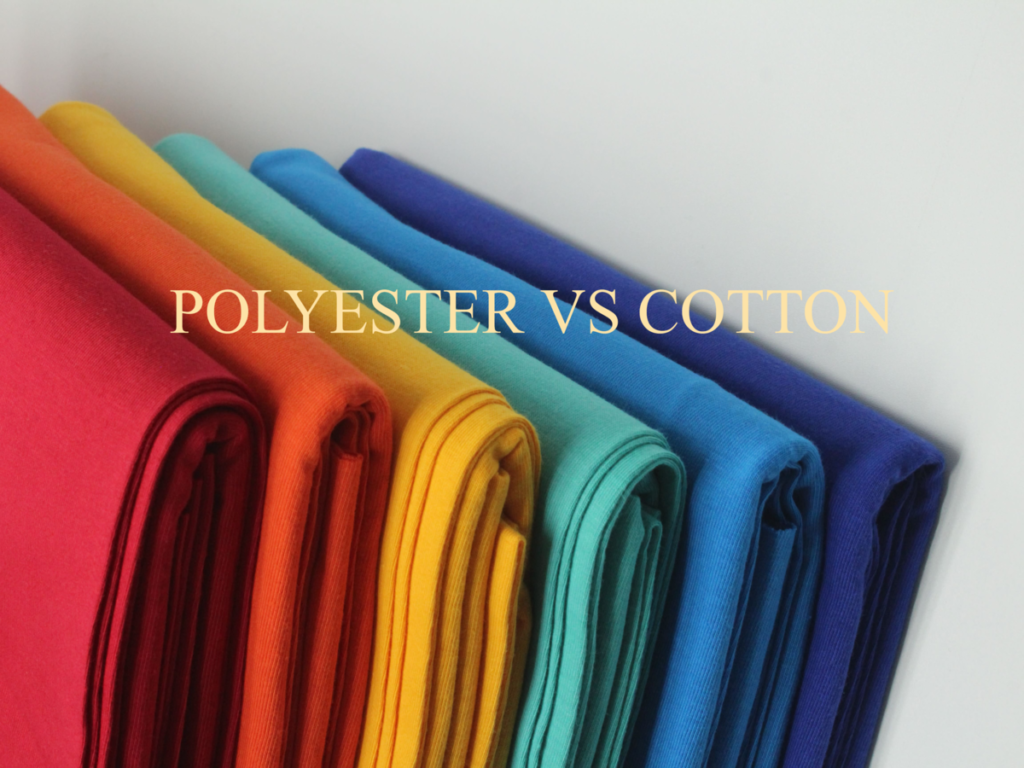If you are someone who wants to get your clothes manufactured, your choice of fabrics plays an all-important role. It decides the fit, design, dyeing and printing capabilities, and several other critical parameters apart from the wearer’s experience and comfort.
Given that, we critically scan the two most important fabrics of the apparel and home décor world- cotton and polyester! The popularity of these wonder fabrics is not likely to wane anytime soon! But are they suitable for just about everything and every occasion?
Here, we compare the two and understand their strengths and weaknesses to make a more educated choice for different projects! Read on!

Getting Insight into Cotton

Cotton fibres are obtained from annually grown plants. It is composed of pure cellulose. It is a soft, comfortable, breathable, hypoallergenic, and durable material. It is one of the oldest fabrics known to man and is highly versatile in its uses.
Its fibre is an eternal favourite material for making carpets, clothing, and upholstery. It is also the first choice for all apparel like custom t-shirts, custom hoodies, shirts, dresses, etc.
On the flip side, the fabric shrinks on washing, wrinkles, wears and tears over time, and does not dry quickly due to its high absorbency.
The fabric is your ultimate choice for sensitive skin and hot and humid climatic conditions.
Cotton is primarily available in three fibre lengths, which decide its cost and use. The longest fibre forms the premium fabric with a price tag attached. The medium length is often used for everyday wear and other usages. In contrast, the short-staple is used for low-quality items, carpets, etc.
Today, we know of about 50 cotton fabrics crafted by mixing, treating, and using different spinning techniques with cotton and other fibre strands.
Getting Insight into Polyester

Polyester is hailed as the opposite material of cotton. First crafted in the 1940s, it is a manufactured synthetic material. Like cotton, it is a high-in-demand fabric with custom clothing manufacturers and home décor items.
It is lighter but denser and more durable than cotton as a petroleum-based synthetic fibre. Ever since the 1970s, it became famous as a cheaper alternative to cotton, especially for outdoor apparel, due to its properties like quick-dry, moisture-wicking, etc. Its custom hoodies or custom t-shirts are trendy. Do check out mgoofashion.com to understand its actual range.
However, this easy maintenance, the quick-dry crease-resistant fabric is not without drawbacks. Feeling plastic-like and cold against the skin, the material is unbreathable, non-sustainable, and tends to melt under excess heat. Hence, the fabric is not meant for all, especially those with sensitive and allergic skin.
Cotton Vs. Polyester- Pitted Against Each Other
Both cotton and polyester are so popular that many use them interchangeably. But their proper use can only come with an understanding of how these materials fare on different parameters of useability.
Hence, we compare them to several critical traits to highlight the advantages and disadvantages of each fabric.
The Feel and Wear of Custom T-Shirts
We have taken t-shirts as standard as perhaps they are the most commonly worn apparel of these fabrics.
A versatile fibre, cotton yields different fabrics like denim, jersey, flannel, etc. The fabrics are formed by weaving and knitting them differently. Each cotton fabric gives a different kind of feel, thickness, and wearability. Despite that, all cotton fabrics.
● Feel soft and comfortable against the skin.
● Do not cling to the skin.
● Absorbs sweat but dries slowly due to lower moisture-wicking property.
● Tend to lose its shape and may pose draping challenges.
● Do not hold odours.
In contrast, polyester
● Feels lighter and silkier than cotton against the skin.
● Feels clammy in warm weather as it traps the sweat but feels warm during cooler weather.
● Being a synthetic material, it can irritate the skin.
● Does not absorb sweat and dries fast as it has better moisture-wicking properties.
● Does not lose its shape and drapes well.
● Tends to hold odours for long, thereby needing a frequent wash.
Shrinkage, Durability, and Wrinkling

Cotton is far more vulnerable to shrinkage and wrinkling, especially when washed with hot water. It tends to get damaged and incur wear and tear with usage.
In contrast, polyester is far more durable than cotton and is less prone to wrinkling. Shrinkage is also absent here as it is primarily plastic. Hence, they drape far better and barely lose their shape. They can withstand the frequent wash, wear and tear much better.
Staining
The high absorbency of cotton makes it easy to stain. Moreover, it can be a daunting task to eliminate the stain.
In contrast, polyester is highly stain-resistant and terrific for rough wear.
Maintenance and Care

Cotton needs higher maintenance and gentler care than polyester to remain in top form. Despite that, it tends to fade, lose shape, and wear and tear out over time, though it can withstand heat well and is washable with hot water.
On the other hand, polyester is a breeze to maintain and take care of. It stays in great shape and retains its colors for a long time despite frequent washes. However, the fabric can melt under high heat, and hence you must always wash the fabric with cold to lukewarm water.
Printing Suitability
Cotton provides an excellent surface for all kinds of colors and various printing techniques. Custom clothing manufacturers like MGOO are highly experimentative and offer some mind-boggling colors and prints.
However, colors might not come too solidly on thick cotton fabrics. Moreover, the color and prints fade over time as the fabric loosely holds dyes.
The story is different with polyester. Initially, it was not too suitable for printing but dyed well. However, the latest printing technologies have made polyester an excellent fabric for vibrant colors and high-quality prints. Additionally, the fabric retains its colors and prints well and seldom fades.
Ability to Biodegrade
Going green and being sustainable is an important consideration today. Hence, we cannot ignore this all-important factor.
Since cotton is a natural and biological material, it degrades more quickly.
On the other hand, synthetic polyester does not biodegrade smoothly and typically remains intact.
Environmental Impact
Both plants impact the environment though polyester might have a slight edge.
While cotton is plant-based, it needs a significant amount of water, energy, and toxic pesticides and chemicals in its cultivation and manufacturing process. However, because it biodegrades, it does not cause landfills.
Polyester is crafted from petroleum and has a comparatively low impact on the environment in its manufacturing process. It causes landfills because of its non-biodegradable property. However, the effect can be significantly reduced by using recycled polyester.
Cost For the Material

The cost of both cotton and polyester depends on several factors. While cotton is a plant, it is more sustainable and traded as a commodity future. Its pricing depends on whether it has been organically grown, its quality, and the fiber’s treatment and spinning technique.
In contrast, the manufacture of polyester is dependent on the price and availability of petroleum, a highly volatile market product.
Despite this, polyester is most often cheaper than cotton.
Ability to Blend with Other Fabrics
Both cotton and polyester demonstrate excellent ability to blend with other fabrics and enhance their traits.
Few leading fabrics that blend well with cotton are polyester, linen, spandex, viscose, lycra, rayon, etc.
Polyester blends well with cotton and wool.
A trendy blend is that of polyester and cotton. It makes the apparel cheaper, more resistant to wrinkling, sweat, and shrinkage, helps retain colour and prints better, etc. Overall, it helps negate each fabric’s drawbacks and enhances its strengths for an overall better fabric.
As for more fabric types, you can visit our fabric page now.
Wrapping Up
As evident, each fabric has its strength and weakness. The suitability of any fabric will depend on the wearer and its intended use. We hope that understanding the similarities and differences of these fibres will help you exploit their incredible versatility and use them for diversified applications.
For further queries, contact us today. We look forward to a marvellous association celebrating these magnificent fabrics!

